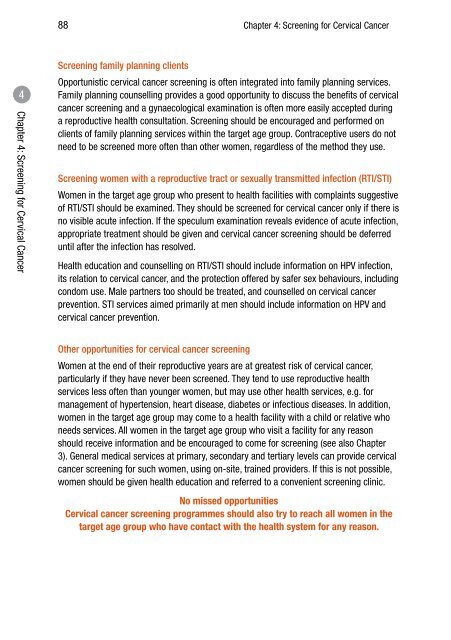CHAPTER 4: SCREENING FOR CERVICAL CANCER
CHAPTER 4: SCREENING FOR CERVICAL CANCER
CHAPTER 4: SCREENING FOR CERVICAL CANCER
You also want an ePaper? Increase the reach of your titles
YUMPU automatically turns print PDFs into web optimized ePapers that Google loves.
88Chapter 4: Screening for Cervical Cancer4Chapter 4: Screening for Cervical CancerScreening family planning clientsOpportunistic cervical cancer screening is often integrated into family planning services.Family planning counselling provides a good opportunity to discuss the benefits of cervicalcancer screening and a gynaecological examination is often more easily accepted duringa reproductive health consultation. Screening should be encouraged and performed onclients of family planning services within the target age group. Contraceptive users do notneed to be screened more often than other women, regardless of the method they use.Screening women with a reproductive tract or sexually transmitted infection (RTI/STI)Women in the target age group who present to health facilities with complaints suggestiveof RTI/STI should be examined. They should be screened for cervical cancer only if there isno visible acute infection. If the speculum examination reveals evidence of acute infection,appropriate treatment should be given and cervical cancer screening should be deferreduntil after the infection has resolved.Health education and counselling on RTI/STI should include information on HPV infection,its relation to cervical cancer, and the protection offered by safer sex behaviours, includingcondom use. Male partners too should be treated, and counselled on cervical cancerprevention. STI services aimed primarily at men should include information on HPV andcervical cancer prevention.Other opportunities for cervical cancer screeningWomen at the end of their reproductive years are at greatest risk of cervical cancer,particularly if they have never been screened. They tend to use reproductive healthservices less often than younger women, but may use other health services, e.g. formanagement of hypertension, heart disease, diabetes or infectious diseases. In addition,women in the target age group may come to a health facility with a child or relative whoneeds services. All women in the target age group who visit a facility for any reasonshould receive information and be encouraged to come for screening (see also Chapter3). General medical services at primary, secondary and tertiary levels can provide cervicalcancer screening for such women, using on-site, trained providers. If this is not possible,women should be given health education and referred to a convenient screening clinic.No missed opportunitiesCervical cancer screening programmes should also try to reach all women in thetarget age group who have contact with the health system for any reason.
















